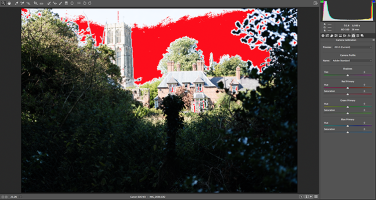Sporgon said:
rishi_sanyal said:
privatebydesign said:
No you haven't. You argue semantics, ad nauseum, meanwhile you avoid any mention of many of the points that have been raised about you.
My pet peeve is the 5dsr image you used to demonstrate poor dr,
Post the RAW and prove me wrong.
No, it's not, and I'm tired of arguing this with you. All you and others have done is raise completely invalid points about how because the flash and background exposure are independent, I could've nailed the perfect exposure.
What does the flash have to do with this?? ???
I never once talked about the model exposure
You're throwing so many red herrings your writing is beginning to smell quite fishy

The red herring was actually coming from those talking about the model exposure, which has absolute nothing to do with the DR limitations I mentioned.
??
Sporgon said:
rishi_sanyal said:
the photographer wants to ensure the colors in the sky aren't lost while actually, you know, trying to take pictures. That is, direct the model/set up the lighting/focus/compose, etc.
I have little interest in engaging in such irrational arguments (it's too bad - for my own health - that I have enough of an interest to respond at all...)
It's not an irrational argument; far from it. What you say might well have been true with the raw converters of the mid 2000's. Are you still using the ACR from 2003 ? These recent cameras are extremely robust in the highlights,
Going to stop you right there. No camera is better than another at highlight recovery, so it doesn't matter what software I'm using. This is a fundamental property of current CMOS linear capture. So your anecdotal examples of how much highlight you recovered in this or that shot means nothing - you could recover that much from a Nikon, or Sony, or what have you shot as well. That's why we look at the shadows, where read noise performance differences between cameras
do make a difference in DR.
Sporgon said:
yet in your example the highlights were reds and yellows anyway - much more robust.
My example was after -100 Highlights, -100 Whites, latest ACR, negative exposure gradients in the sky, with saturation boosts.
The original OOC JPEG had lost most of the tones in the gradient in the sky to a clipped yellow approaching white.
You think that sky is how the original exposure looked? I'm beginning to understand the source of all your erroneous claims about how dishonest that 5DS example was... it was your poor assumptions all along.
Sporgon said:
Do you actually experiment with these cameras to see how far you can push them to your advantage ? I do when I get a body I haven't used before. I'm attaching a shot taken with the M3 (you know, that camera ) where i was seeing how far I could push the over exposure of a blue sky, at mid day, and pull full detail back in ACR. You can see that even the histogram is telling me that I've clipped, yet the resultant pull has kept full detail, with nothing lost in the blue of the sky.
Yes, we do. Your anecdotal example is just that: an anecdotal example irrelevant to higher DR scenes. And I can think of a million scenes with far more DR than the tiny DR scene you've chosen as your example...
Furthermore, this is why our actual tests aren't anecdotal - our studio comparisons level the playing field, and show differences between cameras. Up to you to decide and figure out how they translate to real world shooting, since we can't encompass all real world scenarios in our test scene. We'd love, but we can't, so we try to provide perspective where we can (and do real-world sunset shootouts, which are then pulled apart for not being 0.01% closer to the perfect
Sporgon said:
The point with your 5Ds image is that the highlights are under exposed by at least 1.5 stops,
Incorrect. Less than one stop according to RawDigger. How/why are you
assuming it was 'at least 1.5 stops'?
Sporgon said:
resulting in you lifting the dark shadows off the sensor floor where it has recorded virtually zero detail in very thin light.
A 3 EV push (around what I did of the foreground grass) of ISO 250 is equivalent to ISO 2000. So then are you claiming that when you take a shot at ISO 2000, you're recording 'virtually zero detail in very thin light' at the level of your sensor prior to ISO amplification? So you never shoot at ISO 2000 or above on full-frame?
The fact remains that a camera with little to no read noise would've rendered that grass just fine (like an ISO 2000 shot), whereas the 5DS didn't. End of story.
Sporgon said:
You can put this to bed by letting us have access to the raw file, but you know you have seriously under exposed those highlights and no one is going to need raw digger to discover that.
I could, but on principle I won't. Because last time I did during a similar discussion, the people who realized we
were in fact less than 1/3 EV from clipping the skies turned to other conspiracy theories. The plane in the background sky had flown further in the Nikon shot, so it was shot later than the Canon shot, which meant a scene with less DR. Ironically, about a half hour after sunset, the
later you shoot, the higher the scene DR. Whoops. Nevermind it only took the plane a matter of seconds to move that much...
It appears some will find any (irrational or simply erroneously deduced) reason to say 'you could've done better', which just wastes my time more. Or they'll apply a massive amount of noise reduction and say 'see it looks OK now!' -- which misses the point entirely.
Worse, it ignores the fact that a better performing camera wouldn't have asked you to perfectly nail exposure within less than a 1/3 EV to get better performance - a laughable expectation for any working pro that isn't a studio or landscape photographer. I just checked my shot both in RawDigger and on the back of the camera. On the back of the camera, the sky is blown to a clipped yellow, and histograms show a clipped red channel (green approaching clipping). RawDigger says tones in the sky are less than 1 EV of clipping (8700 in a 14-bit Raw file), so for the
perfect exposure I could've increased ISO
at most 2/3 EV.
Are you telling me that if you're working in the field and take that shot, then see a clipped yellow sky above the mountains, you're going to think to yourself 'let me raise the ISO exactly 2/3 EV (my shutter speed & aperture have already bottomed out) but definitely not 1 EV... no that would clip my sky gradient!'
If so, you're probably a robot, hardwired into the camera sensor. Kudos. But even if you were, you might also be able to accept the fact that an ISO-invariant (higher base ISO DR, or lower read noise) camera would've allowed you to just not worry, and move on to something far more interesting, like iterating the model pose, heck interacting with the model, changing the key/rim light, etc.
Heck, if I wanted to be really safe and make sure none of the gradient in the sky were lost, I might have even underexposed
more after looking at the clipped channels in the JPEG preview!
To sum up: your entire argument is predicated upon the notion that a photographer who knew what he was doing would obviously have known to - despite a completely clipped yellow sky in the JPEG preview on the back of his camera - raise the ISO from 250 to either 320 or 500, but not 640. In the field. While posing the model, talking to her, choosing focus precisely because F2, placing the rim light, placing the key light, figuring out their proper balance, then figuring out the proper balance of flash to background.
Let's let that sink in...



